Pollution Level, Ecological Risk Assessment and Vertical Distribution Pattern Analysis of Heavy Metals in the Tailings Dam of an Abandon Lead–Zinc Mine
Abstract
1. Introduction
2. Materials and Methods
2.1. Study Area
2.2. Sample Collection and Processing
2.2.1. Field Sampling
2.2.2. Sampling Processing
2.3. Pollution Level
2.3.1. Nemerow Comprehensive Pollution Index
2.3.2. Geoaccumulation Index
2.4. Potential Ecological Risk Index
2.5. Correlation Analysis
3. Results
3.1. The Vertical Distribution of Heavy Metal Concentrations
3.2. Pollution Level Analysis
3.2.1. Nemerow Comprehensive Pollution Index
3.2.2. Geoacculumation Index
3.3. Potential Ecological Risk Assessment
3.4. Differences Analysis
3.5. Investigation of the Heavy Metal Sources
3.6. Exploration of Potential Ecological Hazards
4. Discussion
5. Conclusions
- The concentrations of heavy metals within the reclaimed zone show a significant increasing trend with depth, and there is an enrichment of heavy metals observed at the interface layer. In the tailings layer and deep zone, the variation patterns for the four heavy metal concentrations are not clearly observed, but the contents remain relatively high;
- The pollution degrees of heavy metals in each zone are ranked as (high to low): the interface layer > the tailings layer > the deep zone > the reclaimed zone. The four heavy metals pollute the soil in the descending order of Pb > Zn > As > Cu;
- The interface layer, tailings layer and deep zone exhibit extremely strong PER with the RI values far exceeding 600, while the reclaimed zone shows moderate PER, with an RI value of 172.444. The contribution rates of the four heavy metals to RI are as follows, in descending order: Pb > As > Zn > Cu;
- A common source of heavy metal pollution in the study area has been identified based on correlation analysis, namely the lead–zinc mine. Heavy metal pollution poses a potential threat to water security for humans and the biological resources within the Dongjiang Lake Ecological Protection Area.
Author Contributions
Funding
Institutional Review Board Statement
Informed Consent Statement
Data Availability Statement
Acknowledgments
Conflicts of Interest
References
- Zhao, G.; Ma, Y.; Liu, Y.; Cheng, J.; Wang, X. Source analysis and ecological risk assessment of heavy metals in farmland soils around heavy metal industry in Anxin County. Sci. Rep. 2022, 12, 10562. [Google Scholar] [CrossRef]
- Li, Z.; Ma, Z.; van der Kuijp, T.J.; Yuan, Z.; Huang, L. A review of soil heavy metal pollution from mines in China: Pollution and health risk assessment. Sci. Total Environ. 2014, 468, 843–853. [Google Scholar] [CrossRef]
- Cao, J.; Xie, C.; Hou, Z. Ecological evaluation of heavy metal pollution in the soil of Pb-Zn mines. Ecotoxicology 2022, 31, 259–270. [Google Scholar] [CrossRef] [PubMed]
- Liu, H.; Probst, A.; Liao, B. Metal contamination of soils and crops affected by the Chenzhou lead/zinc mine spill (Hunan, China). Sci. Total Environ. 2005, 339, 153–166. [Google Scholar] [CrossRef] [PubMed]
- Li, J.; Xie, Z.M.; Xu, J.M.; Sun, Y.F. Risk assessment for safety of soils and vegetables around a lead/zinc mine. Environ. Geochem. Health 2006, 28, 37–44. [Google Scholar] [CrossRef]
- Li, Y.; Wang, Y.B.; Gou, X.; Su, Y.B.; Wang, G. Risk assessment of heavy metals in soils and vegetables around non-ferrous metals mining and smelting sites, Baiyin, China. J. Environ. Sci. 2006, 18, 1124–1134. [Google Scholar] [CrossRef]
- Zhuang, P.; Zou, B.; Li, N.Y.; Li, Z.A. Heavy metal contamination in soils and food crops around Dabaoshan mine in Guangdong, China: Implication for human health. Environ. Geochem. Health 2009, 31, 707–715. [Google Scholar] [CrossRef] [PubMed]
- Štofejová, L.; Fazekaš, J.; Fazekašová, D. Analysis of heavy metal content in soil and plants in the dumping ground of Magnesite Mining Factory Jelšava-Lubeník (Slovakia). Sustainability 2021, 13, 4508. [Google Scholar] [CrossRef]
- Sonone, S.S.; Jadhav, S.; Sankhla, M.S.; Kumar, R. Water contamination by heavy metals and their toxic effect on aquaculture and human health through food Chain. Lett. Appl. NanoBioSci. 2020, 10, 2148–2166. [Google Scholar] [CrossRef]
- Shi, J.; Zhao, D.; Ren, F.; Huang, L. Spatiotemporal variation of soil heavy metals in China: The pollution status and risk assessment. Sci. Total Environ. 2023, 871, 161768. [Google Scholar] [CrossRef]
- Wang, Q.; Li, Z.; Xu, Y.; Li, R.; Zhang, M. Adaptive-weight water quality assessment and human health risk analysis for river water in Hong Kong. Environ. Sci. Pollut. Res. 2022, 29, 75936–75954. [Google Scholar] [CrossRef]
- Rahman, H.H.; Yusuf, K.K.; Niemann, D.; Dipon, S.R. Urinary speciated arsenic and depression among US adults. Environ. Sci. Pollut. Res. 2020, 27, 23048–23053. [Google Scholar] [CrossRef]
- Muenyi, C.S.; Ljungman, M.; States, J.C. Arsenic Disruption of DNA Damage Responses—Potential Role in Carcinogenesis and Chemotherapy. Biomolecules 2015, 5, 2184–2193. [Google Scholar] [CrossRef]
- Vareda, J.P.; Valente, A.J.; Durães, L. Assessment of heavy metal pollution from anthropogenic activities and remediation strategies: A review. J. Environ. Manag. 2019, 246, 101–118. [Google Scholar] [CrossRef] [PubMed]
- Vuong, X.T.; Vu, L.D.; Duong, A.T.T.; Duong, H.T.; Hoang, T.H.T.; Luu, M.N.T.; Nguyen, T.N.; Nguyen, V.D.; Nguyen, T.T.T.; Van, T.H.; et al. Speciation and environmental risk assessment of heavy metals in soil from a lead/zinc mining site in Vietnam. Int. J. Environ. Sci. Technol. 2023, 20, 5295–5310. [Google Scholar] [CrossRef]
- Gujre, N.; Rangan, L.; Mitra, S. Occurrence, geochemical fraction, ecological and health risk assessment of cadmium, copper and nickel in soils contaminated with municipal solid wastes. Chemosphere 2021, 271, 129573. [Google Scholar] [CrossRef]
- He, W.; He, Q.; Zhou, J. Soil weathering-water environment-ecological risks in Hanjiang River Basin, China. Quat. Int. 2015, 380, 297–304. [Google Scholar] [CrossRef]
- Zhong, S.; Geng, H.; Zhang, F.; Liu, Z.; Wang, T.; Song, B. Risk assessment and prediction of heavy metal pollution in groundwater and river sediment: A case study of a typical agricultural irrigation area in Northeast China. Int. J. Anal. Chem. 2015, 2015, 921539. [Google Scholar] [CrossRef]
- Chen, Y.; Jiang, X.; Wang, Y.; Zhuang, D. Spatial characteristics of heavy metal pollution and the potential ecological risk of a typical mining area: A case study in China. Process Saf. Environ. Protect. 2018, 113, 204–219. [Google Scholar] [CrossRef]
- Chen, W.; Zhu, K.; Cai, Y.; Wang, Y.; Liu, Y. Distribution and ecological risk assessment of arsenic and some trace elements in soil of different land use types, Tianba Town, China. Environ. Technol. Innov. 2021, 24, 102041. [Google Scholar] [CrossRef]
- Xu, X.; Wang, T.; Sun, M.; Bai, Y.; Fu, C.; Zhang, L.; Hu, X.; Hagist, S. Management principles for heavy metal contaminated farmland based on ecological risk—A case study in the pilot area of Hunan province, China. Sci. Total Environ. 2019, 684, 537–547. [Google Scholar] [CrossRef]
- Kowalska, J.B.; Mazurek, R.; Gąsiorek, M.; Zaleski, T. Pollution indices as useful tools for the comprehensive evaluation of the degree of soil contamination–A review. Environ. Geochem. Health 2018, 40, 2395–2420. [Google Scholar] [CrossRef] [PubMed]
- Yari, A.A.; Varvani, J.; Zare, R. Assessment and zoning of environmental hazard of heavy metals using the Nemerow integrated pollution index in the vineyards of Malayer city. Acta Geophys. 2021, 69, 149–159. [Google Scholar] [CrossRef]
- Wang, X.; Sun, Y.; Li, S.; Wang, H. Spatial distribution and ecological risk assessment of heavy metals in soil from the Raoyanghe Wetland, China. PLoS ONE 2019, 14, e0220409. [Google Scholar] [CrossRef]
- Huang, S.W.; Jin, J.Y. Status of heavy metals in agricultural soils as affected by different patterns of land use. Environ. Monit. Assess. 2008, 139, 317–327. [Google Scholar] [CrossRef]
- Muller, G. Index of geoaccumulation in sediments of the Rhine River. Geojournal 1969, 2, 108–118. [Google Scholar]
- Okedeyi, O.O.; Dube, S.; Awofolu, O.R.; Nindi, M.M. Assessing the enrichment of heavy metals in surface soil and plant (Digitaria eriantha) around coal-fired power plants in South Africa. Environ. Sci. Pollut. Res. 2014, 21, 4686–4696. [Google Scholar] [CrossRef]
- Adimalla, N. Heavy metals contamination in urban surface soils of Medak province, India, and its risk assessment and spatial distribution. Environ. Geochem. Health 2020, 42, 59–75. [Google Scholar] [CrossRef]
- Jamal, A.; Delavar, M.A.; Naderi, A.; Nourieh, N.; Medi, B.; Mahvi, A.H. Distribution and health risk assessment of heavy metals in soil surrounding a lead and zinc smelting plant in Zanjan, Iran. Hum. Ecol. Risk Assess. Int. J. 2018, 25, 1018–1033. [Google Scholar] [CrossRef]
- Nasirian, H.; Irvine, K.N.; Sadeghi, S.M.T.; Mahvi, A.H.; Nazmara, S. Assessment of bed sediment metal contamination in the Shadegan and Hawr Al Azim wetlands, Iran. Environ. Monit. Assess. 2016, 188, 107. [Google Scholar] [CrossRef] [PubMed]
- Cheng, J.L.; Shi, Z.; Zhu, Y.W. Assessment and mapping of environmental quality in agricultural soils of Zhejiang Province, China. J. Environ. Sci. 2007, 19, 50–54. [Google Scholar] [CrossRef] [PubMed]
- Brady, J.P.; Ayoko, G.A.; Martens, W.N.; Goonetilleke, A. Development of a hybrid pollution index for heavy metals in marine and estuarine sediments. Environ. Monit. Assess. 2015, 187, 306. [Google Scholar] [CrossRef]
- Mazurek, R.; Kowalska, J.; Gąsiorek, M.; Zadrożny, P.; Józefowska, A.; Zaleski, T.; Kępka, W.; Tymczuk, M.; Orłowska, K. Assessment of heavy metals contamination in surface layers of Roztocze National Park forest soils (SE Poland) by indices of pollution. Chemosphere 2017, 168, 839–850. [Google Scholar] [CrossRef] [PubMed]
- Solgi, E.; Esmaili-Sari, A.; Riyahi-Bakhtiari, A.; Hadipour, M. Soil contamination of metals in the three industrial estates, Arak, Iran. Bull. Environ. Contam. Toxicol. 2012, 88, 634–638. [Google Scholar] [CrossRef] [PubMed]
- Yang, Q.; Li, Z.; Lu, X.; Duan, Q.; Huang, L.; Bi, J. A review of soil heavy metal pollution from industrial and agricultural regions in China: Pollution and risk assessment. Sci. Total Environ. 2018, 642, 690–700. [Google Scholar] [CrossRef]
- Hakanson, L. An ecological risk index for aquatic pollution control. A sedimentological approach. Water Res. 1980, 14, 975–1001. [Google Scholar] [CrossRef]
- Liu, Y.; Wang, Q.; Zhuang, W.; Yuan, Y.; Yuan, Y.; Jiao, K.; Wang, M.; Chen, Q. Calculation of Thallium’s toxicity coefficient in the evaluation of potential ecological risk index: A case study. Chemosphere 2018, 194, 562–569. [Google Scholar] [CrossRef]
- Li, Y.; Li, P.; Liu, L. Source identification and potential ecological risk assessment of heavy metals in the topsoil of the Weining Plain (Northwest China). Expo. Health 2022, 14, 281–294. [Google Scholar] [CrossRef]
- Kumar, V.; Pandita, S.; Setia, R. A meta-analysis of potential ecological risk evaluation of heavy metals in sediments and soils. Gondwana Res. 2022, 103, 487–501. [Google Scholar] [CrossRef]
- Yan, N.; Liu, W.; Xie, H.; Gao, L.; Han, Y.; Wang, M.; Li, H. Distribution and assessment of heavy metals in the surface sediment of Yellow River, China. J. Environ. Sci. 2016, 39, 45–51. [Google Scholar] [CrossRef]
- Zhou, L.; Yang, B.; Xue, N.; Li, F.; Seip, H.M.; Cong, X.; Yan, Y.; Liu, B.; Han, B.; Li, H. Ecological risks and potential sources of heavy metals in agricultural soils from Huanghuai Plain, China. Environ. Sci. Pollut. Res. 2014, 21, 1360–1369. [Google Scholar] [CrossRef] [PubMed]
- Cai, J.; Kwan, M.P. Discovering co-location patterns in multivariate spatial flow data. Int. J. Geogr. Inf. Sci. 2022, 36, 720–748. [Google Scholar] [CrossRef]
- Wang, Q.; Li, Z.; Xu, Y.; Li, R.; Zhang, M. Analysis of spatio-temporal variations of river water quality and construction of a novel cost-effective assessment model: A case study in Hong Kong. Environ. Sci. Pollut. Res. 2022, 29, 28241–28255. [Google Scholar] [CrossRef] [PubMed]
- Zeng, L.; Wang, Y.; Jing, L.; Cheng, Q. Quantitative determination of auxiliary information for mapping soil heavy metals and soil contamination risk assessment. Appl. Geochem. 2021, 130, 104964. [Google Scholar] [CrossRef]
- Tian, K.; Huang, B.; Xing, Z.; Hu, W. In situ investigation of heavy metals at trace concentrations in greenhouse soils via portable X-ray fluorescence spectroscopy. Environ. Sci. Pollut. Res. 2018, 25, 11011–11022. [Google Scholar] [CrossRef] [PubMed]
- Peralta, E.; Pérez, G.; Ojeda, G.; Alcañiz, J.M.; Valiente, M.; López-Mesas, M.; Sánchez-Martín, M.J. Heavy metal availability assessment using portable X-ray fluorescence and single extraction procedures on former vineyard polluted soils. Sci. Total Environ. 2020, 726, 138670. [Google Scholar] [CrossRef] [PubMed]
- Manzoor, R.; Zhang, T.; Zhang, X.; Wang, M.; Pan, J.F.; Wang, Z.; Zhang, B. Single and combined metal contamination in coastal environments in China: Current status and potential ecological risk evaluation. Environ. Sci. Pollut. Res. 2018, 25, 1044–1054. [Google Scholar] [CrossRef]
- Baran, A.; Wieczorek, J.; Mazurek, R.; Urbański, K.; Klimkowicz-Pawlas, A. Potential ecological risk assessment and predicting zinc accumulation in soils. Environ. Geochem. Health 2018, 40, 435–450. [Google Scholar] [CrossRef]
- Zhou, W.; Dan, Z.; Meng, D.; Zhou, P.; Chang, K.; Zhuoma, Q.; Wang, J.; Xu, F.; Chen, G. Distribution characteristics and potential ecological risk assessment of heavy metals in soils around Shannan landfill site, Tibet. Environ. Geochem. Health 2023, 45, 393–407. [Google Scholar] [CrossRef]
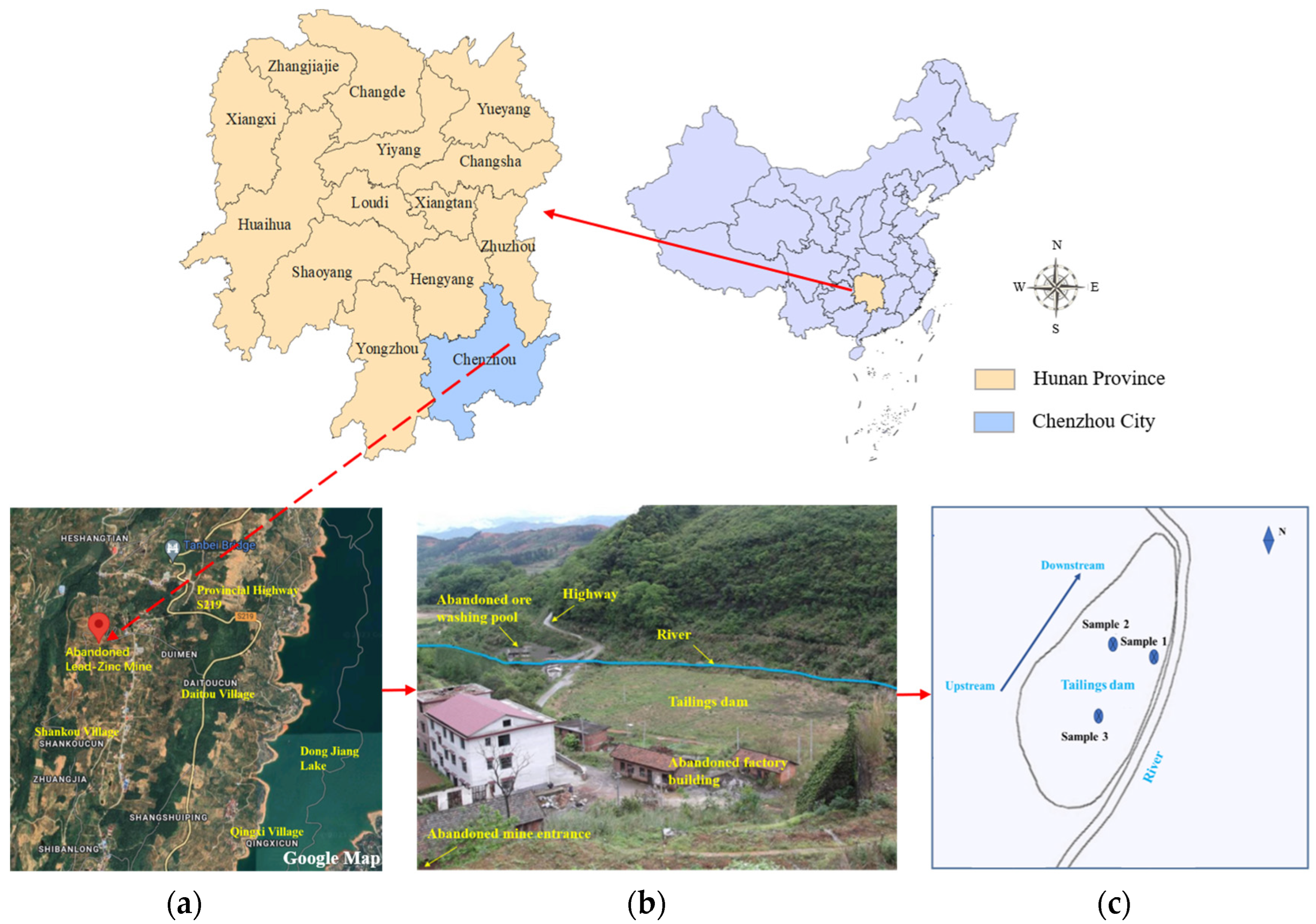

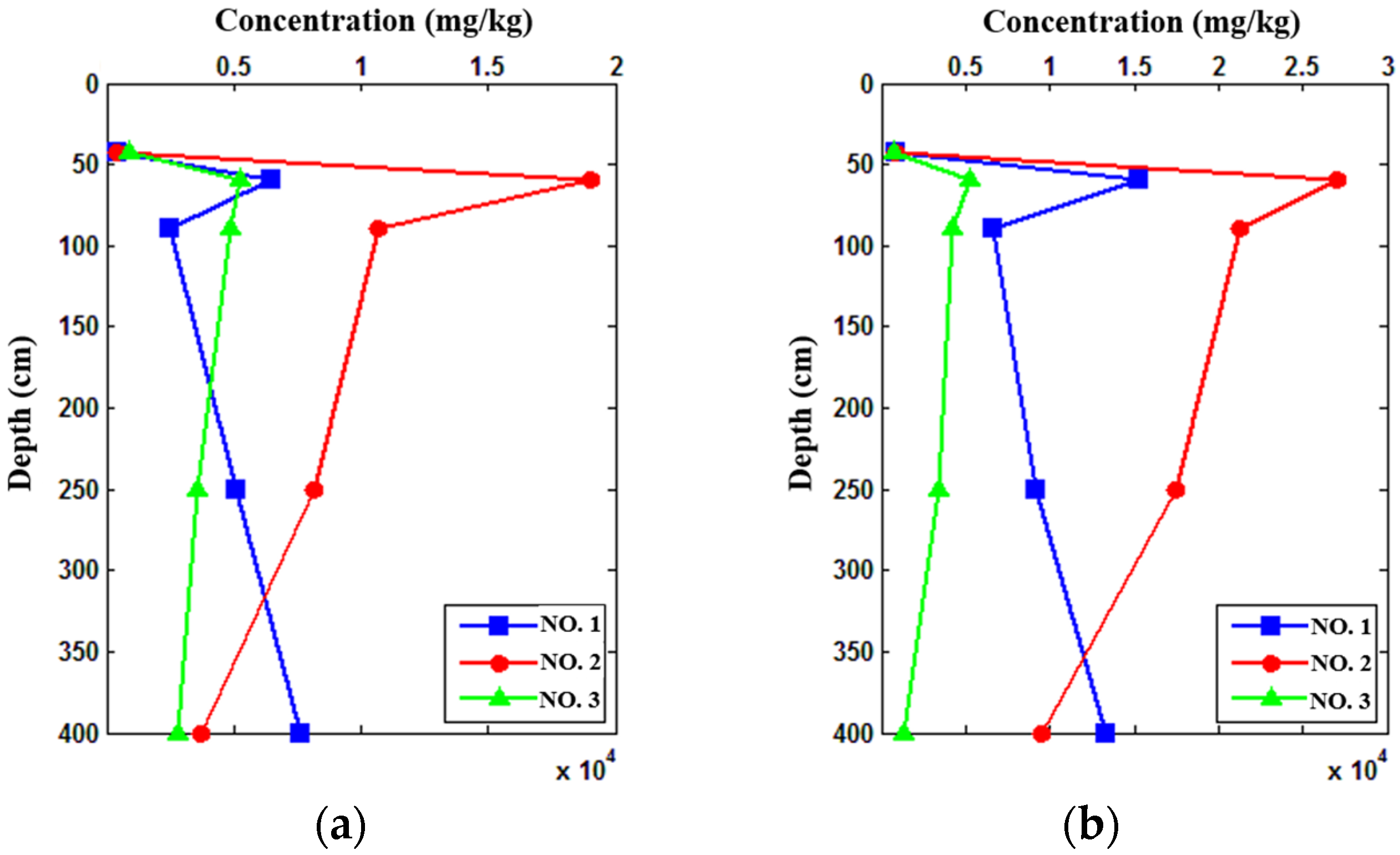
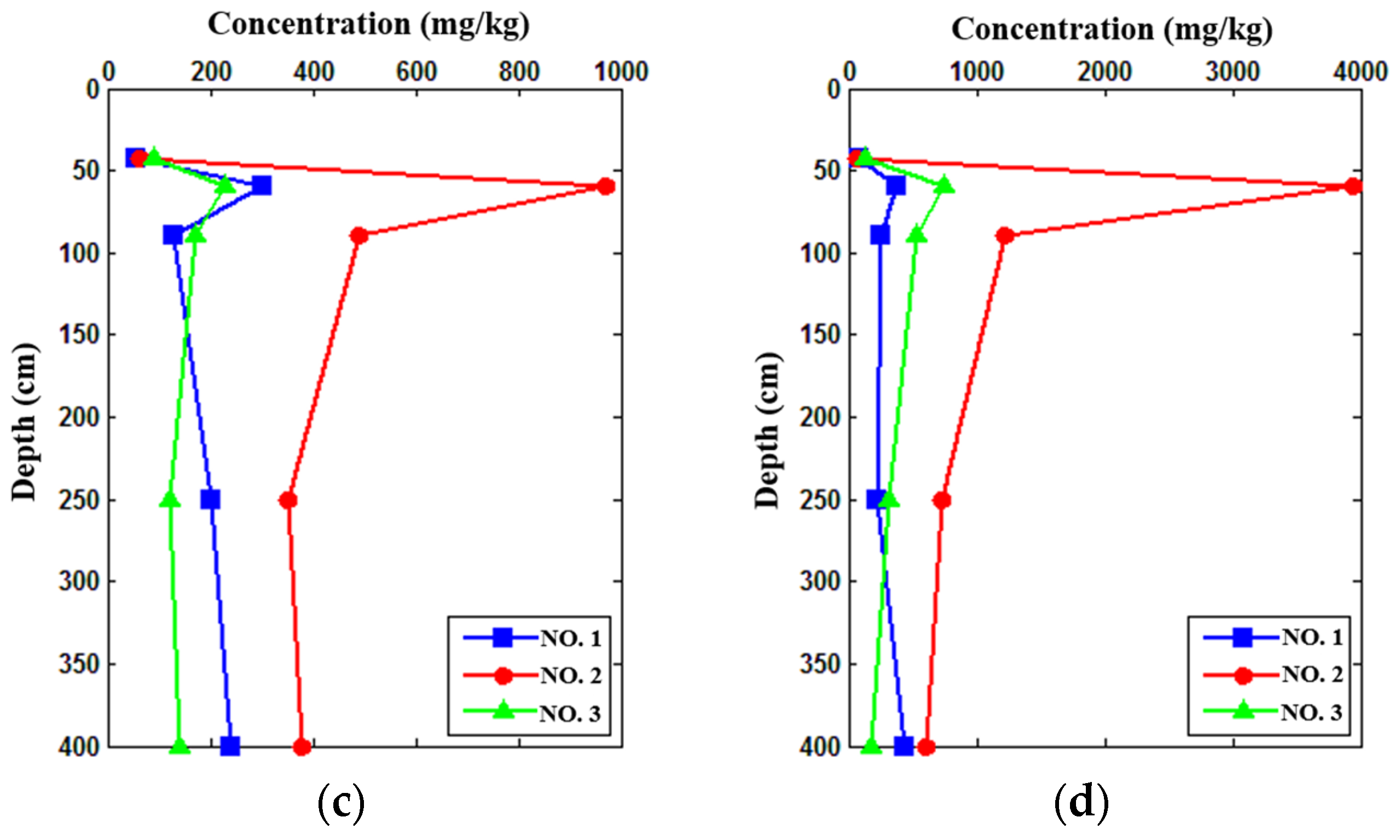
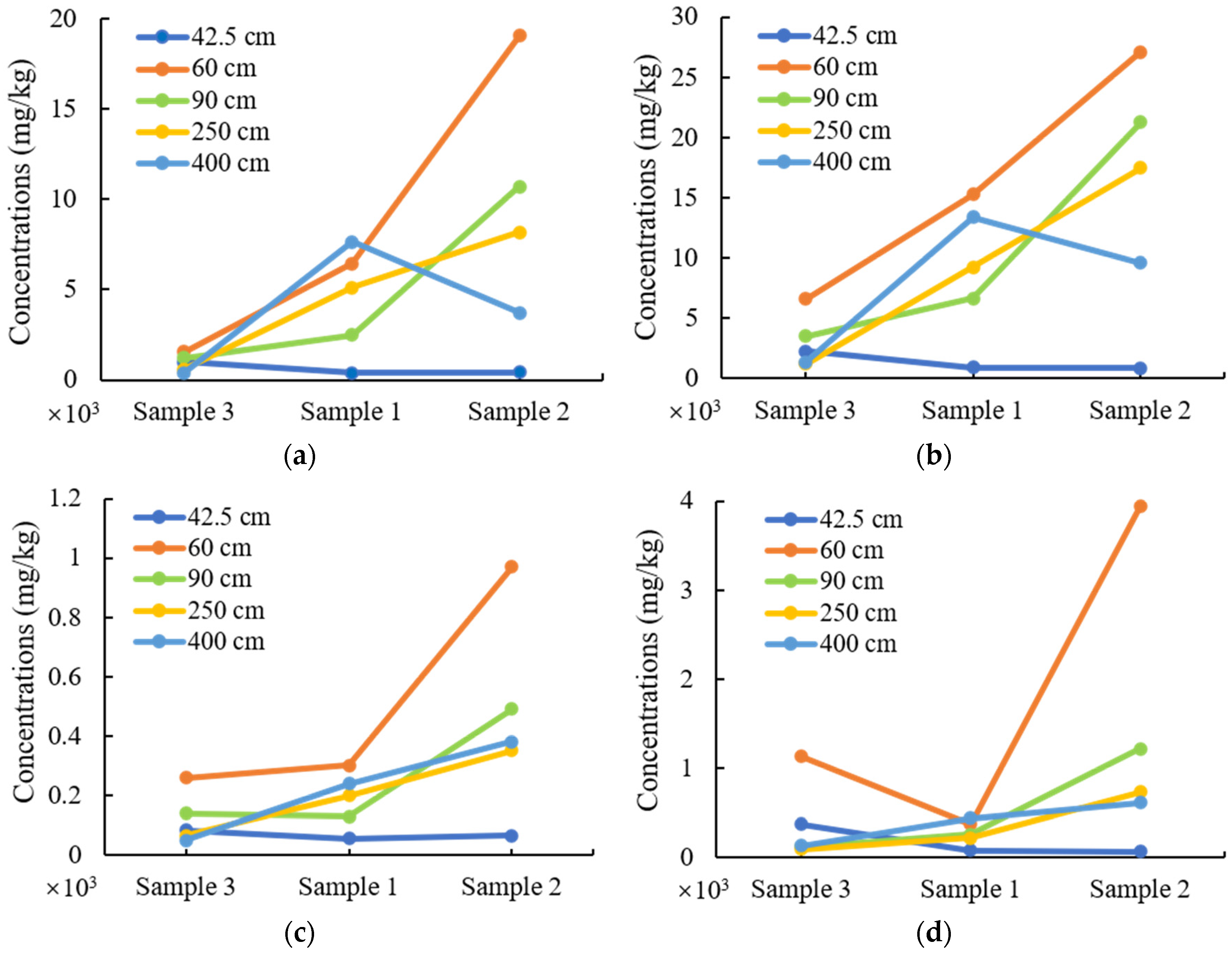
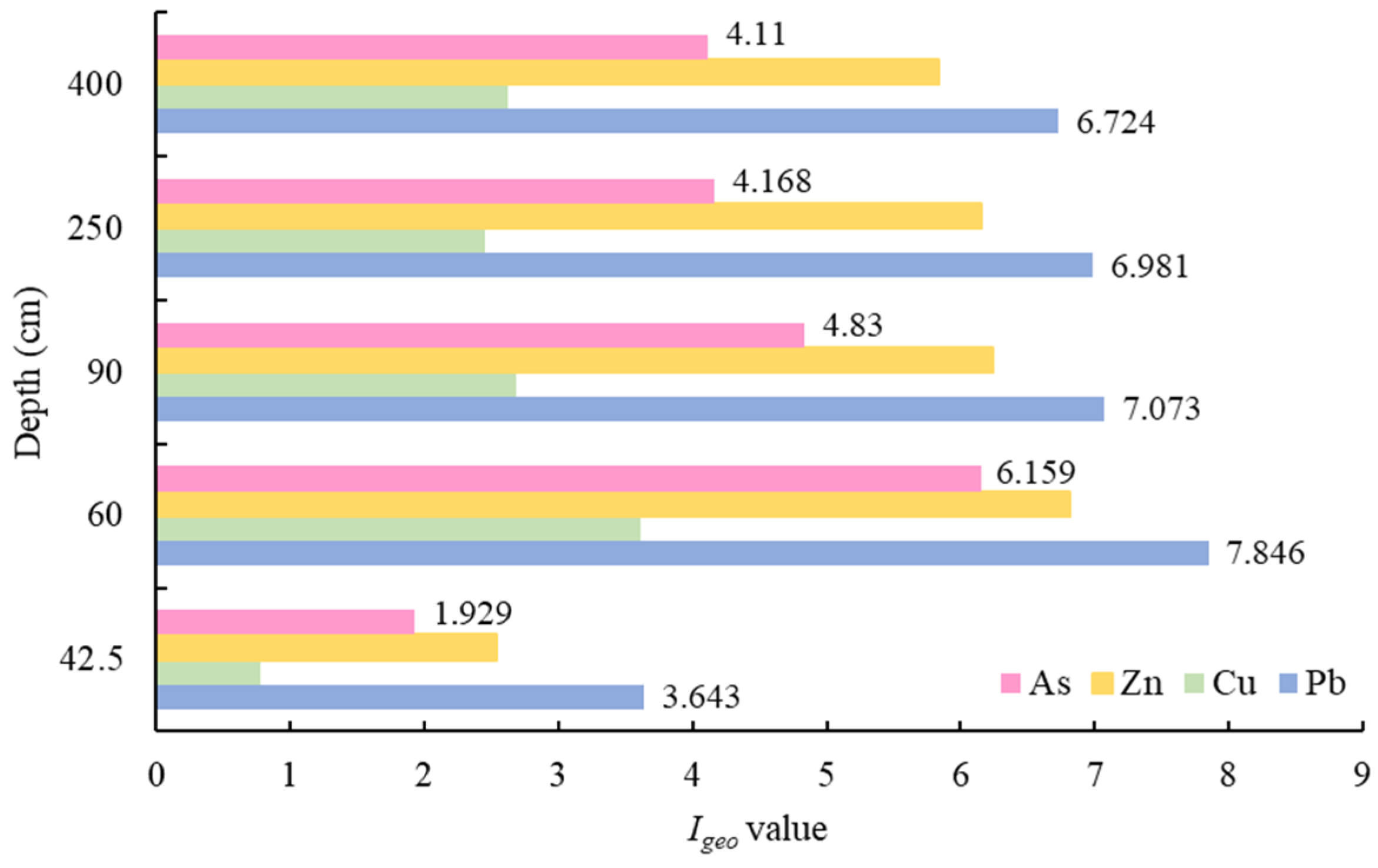
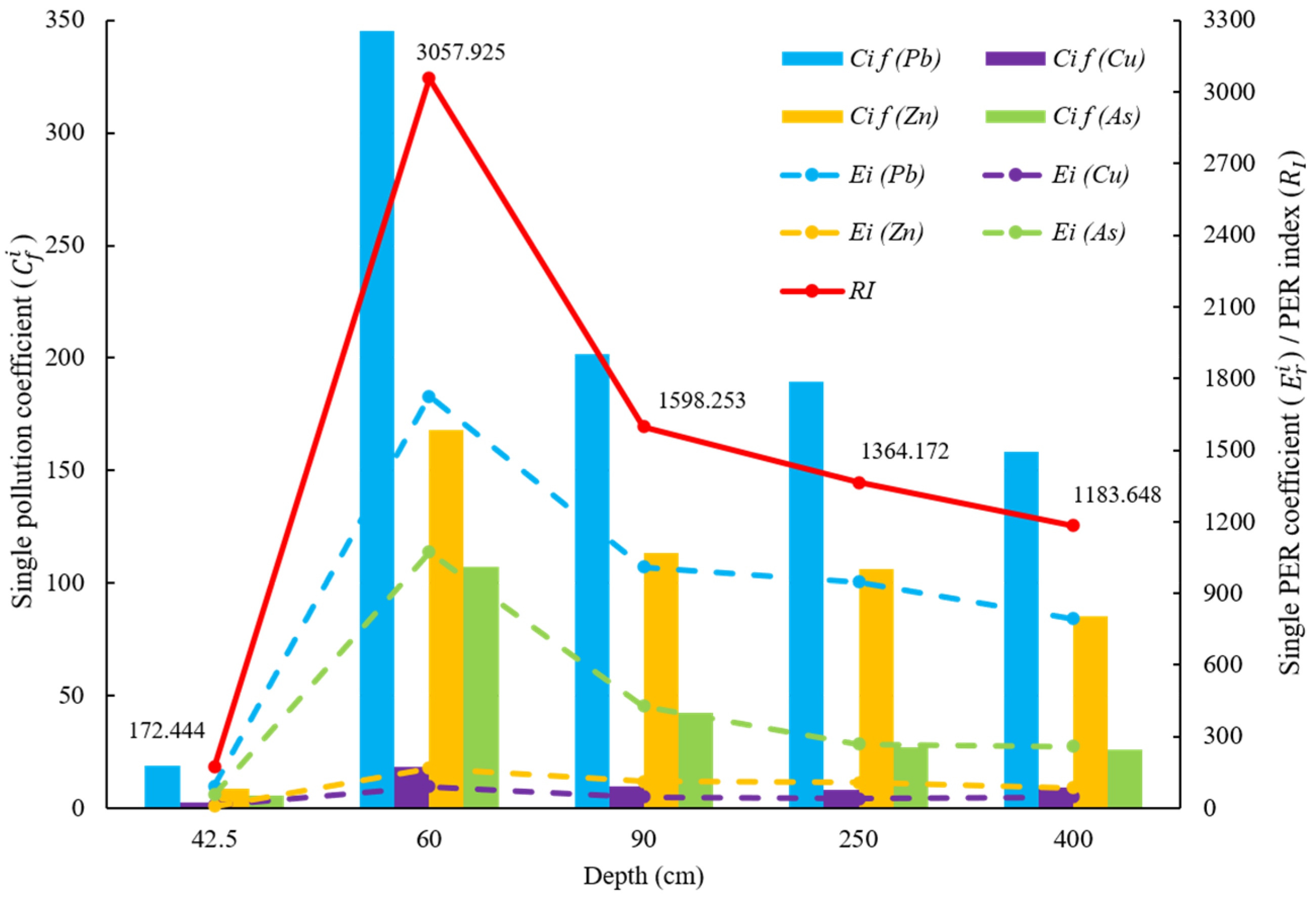
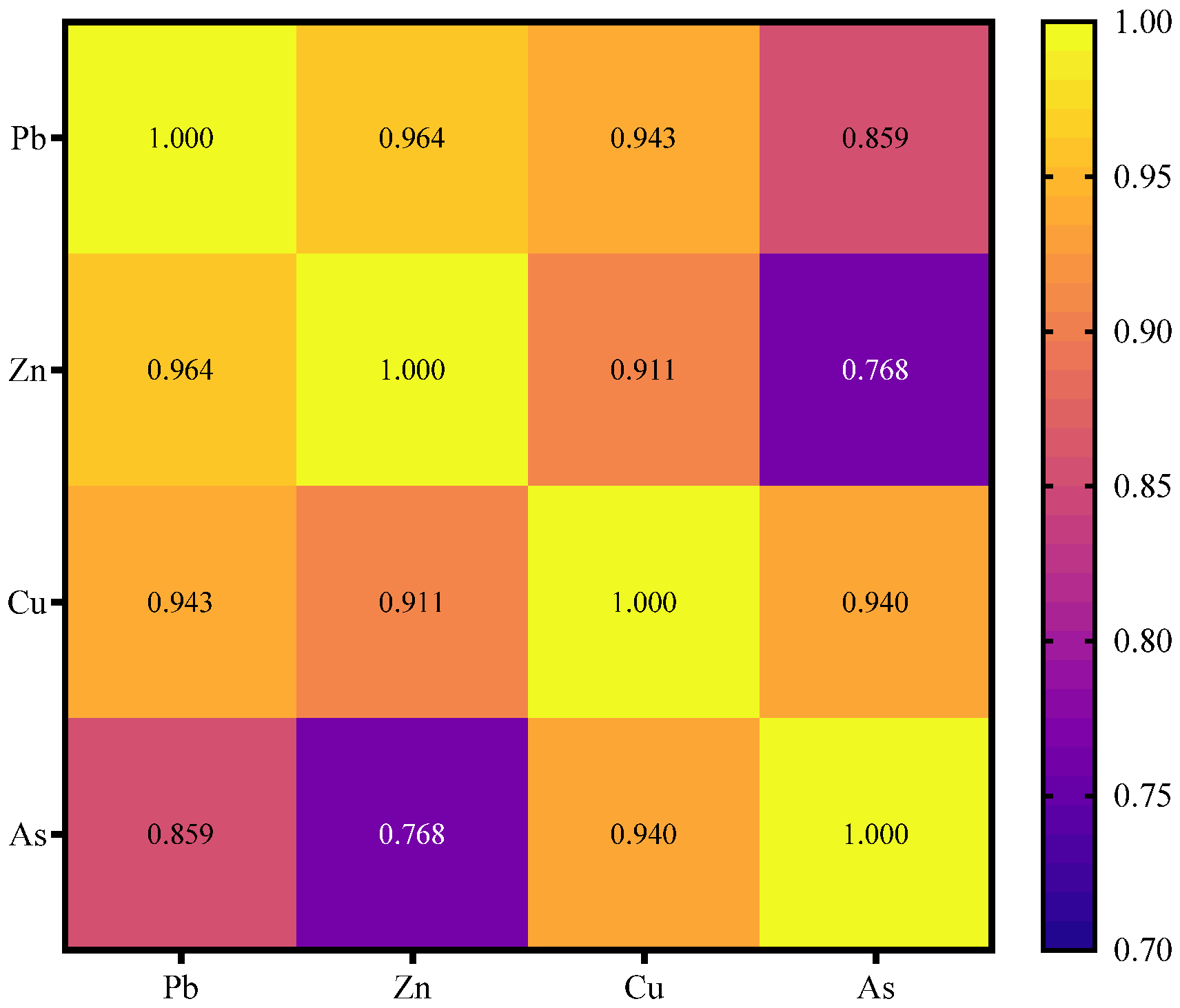
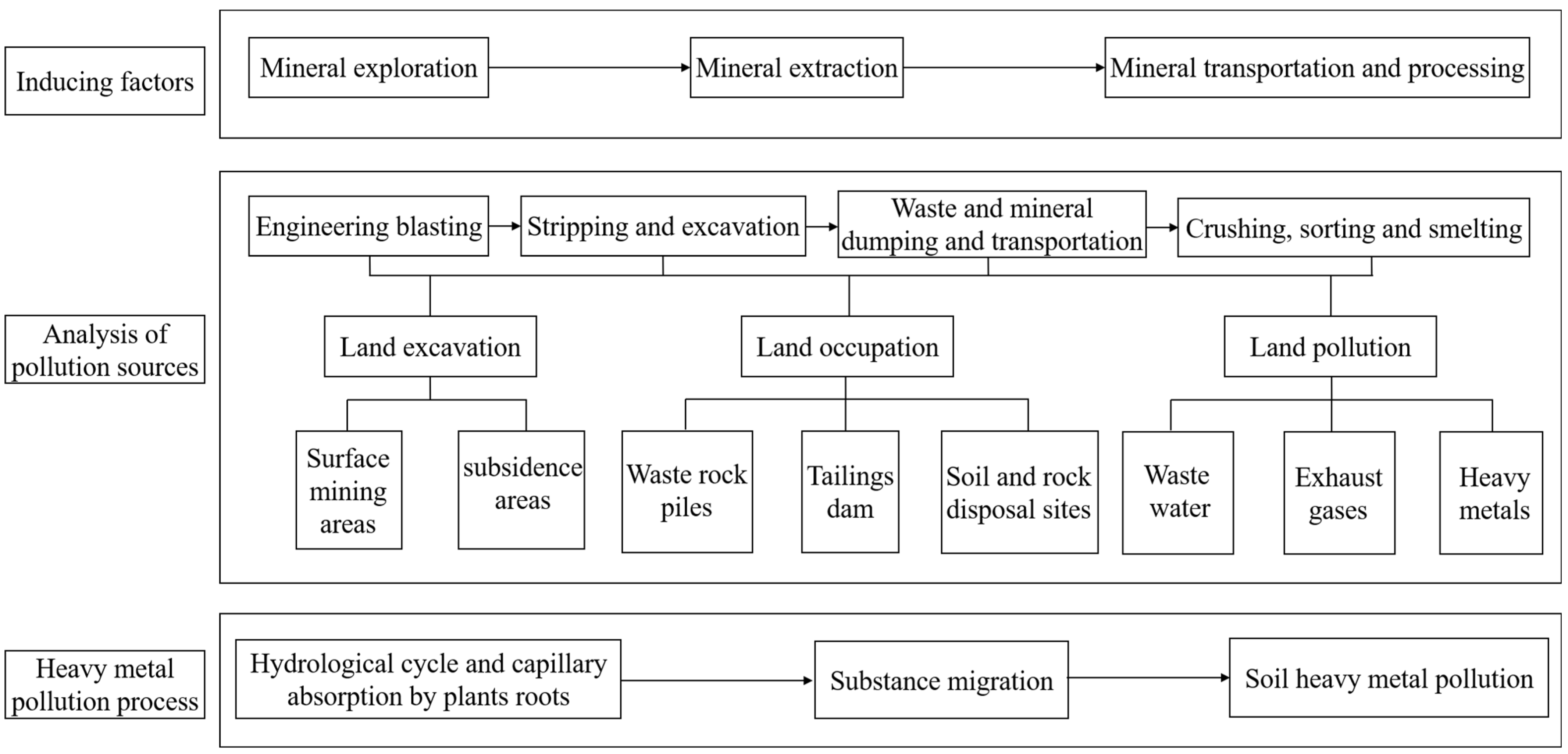
| Grading Level | Pollution Index | Pollution Degree |
|---|---|---|
| I | Pc ≤ 0.7 | Without pollution |
| II | 0.7 < Pc ≤ 1 | Alert limit |
| III | 1 < Pc ≤ 2 | Mild pollution |
| IV | 2 < Pc ≤ 3 | Moderate pollution |
| V | Pc > 3 | Strong pollution |
| Grading Level | Pollution Index | Pollution Degree |
|---|---|---|
| I | ≤ 0 | Without pollution |
| II | 0 < ≤ 1 | Mild pollution–Moderate pollution |
| III | 1 < ≤ 2 | Moderate pollution |
| IV | 2 < ≤ 3 | Moderate pollution–Strong pollution |
| V | 3 < ≤ 4 | Strong pollution |
| VI | 4 < ≤ 5 | Strong pollution–Extremely strong pollution |
| VII | 5 < | Extremely strong pollution |
| Single Pollution Coefficient | Single PER Coefficient | PER Index | |||
|---|---|---|---|---|---|
| Threshold Range | Single Pollution Degree | Threshold Range | Single Ecological Risk Level | Threshold Range | Total Ecological Risk Level |
| < 1 | Mild pollution | < 40 | Mild | RI < 150 | Mild |
| 1 ≤ < 3 | Moderate pollution | 40 ≤ < 80 | Moderate | 150≤ RI < 300 | Moderate |
| 3 ≤ < 6 | Strong pollution | 80 ≤ < 160 | Slightly strong | 300 ≤ RI < 600 | Strong |
| 6 ≤ | Extremely strong | 160 ≤ < 320 | Strong | 600 ≤ RI | Extremely strong |
| pollution | 320 ≤ | Extremely strong | |||
| Sampling No. | Depth (cm) | Single-Factor Pollution Index (Pi) | Nemerow ComprehensivePollution Index (Pc) | |||
|---|---|---|---|---|---|---|
| Pb | Cu | Zn | As | |||
| Sampling 1 | 42.5 | 13.131 | 2.051 | 9.534 | 5.032 | 10.671 |
| 60 | 217.508 | 10.989 | 161.547 | 23.567 | 170.297 | |
| 90 | 83.165 | 4.762 | 70.339 | 16.561 | 66.433 | |
| 250 | 172.727 | 7.326 | 97.564 | 14.013 | 132.571 | |
| 400 | 256.902 | 8.791 | 141.737 | 28.025 | 197.294 | |
| Sampling 2 | 42.5 | 14.478 | 2.381 | 9.004 | 4.140 | 11.530 |
| 60 | 641.751 | 35.531 | 287.182 | 250.955 | 502.082 | |
| 90 | 359.933 | 17.949 | 225.212 | 77.707 | 281.531 | |
| 250 | 275.421 | 12.821 | 185.275 | 46.497 | 215.357 | |
| 400 | 124.916 | 13.919 | 101.377 | 38.854 | 101.172 | |
| Sampling 3 | 42.5 | 28.620 | 3.297 | 7.68 | 7.962 | 21.914 |
| 60 | 176.431 | 8.425 | 55.932 | 47.070 | 134.735 | |
| 90 | 162.795 | 6.227 | 44.809 | 33.758 | 123.153 | |
| 250 | 120.202 | 4.396 | 36.292 | 20.382 | 90.836 | |
| 400 | 93.805 | 5.123 | 13.453 | 10.828 | 69.815 | |
Disclaimer/Publisher’s Note: The statements, opinions and data contained in all publications are solely those of the individual author(s) and contributor(s) and not of MDPI and/or the editor(s). MDPI and/or the editor(s) disclaim responsibility for any injury to people or property resulting from any ideas, methods, instructions or products referred to in the content. |
© 2023 by the authors. Licensee MDPI, Basel, Switzerland. This article is an open access article distributed under the terms and conditions of the Creative Commons Attribution (CC BY) license (https://creativecommons.org/licenses/by/4.0/).
Share and Cite
Wang, Q.; Cai, J.; Gao, F.; Li, Z.; Zhang, M. Pollution Level, Ecological Risk Assessment and Vertical Distribution Pattern Analysis of Heavy Metals in the Tailings Dam of an Abandon Lead–Zinc Mine. Sustainability 2023, 15, 11987. https://doi.org/10.3390/su151511987
Wang Q, Cai J, Gao F, Li Z, Zhang M. Pollution Level, Ecological Risk Assessment and Vertical Distribution Pattern Analysis of Heavy Metals in the Tailings Dam of an Abandon Lead–Zinc Mine. Sustainability. 2023; 15(15):11987. https://doi.org/10.3390/su151511987
Chicago/Turabian StyleWang, Qiaoli, Jiannan Cai, Feng Gao, Zijun Li, and Mengsheng Zhang. 2023. "Pollution Level, Ecological Risk Assessment and Vertical Distribution Pattern Analysis of Heavy Metals in the Tailings Dam of an Abandon Lead–Zinc Mine" Sustainability 15, no. 15: 11987. https://doi.org/10.3390/su151511987
APA StyleWang, Q., Cai, J., Gao, F., Li, Z., & Zhang, M. (2023). Pollution Level, Ecological Risk Assessment and Vertical Distribution Pattern Analysis of Heavy Metals in the Tailings Dam of an Abandon Lead–Zinc Mine. Sustainability, 15(15), 11987. https://doi.org/10.3390/su151511987








